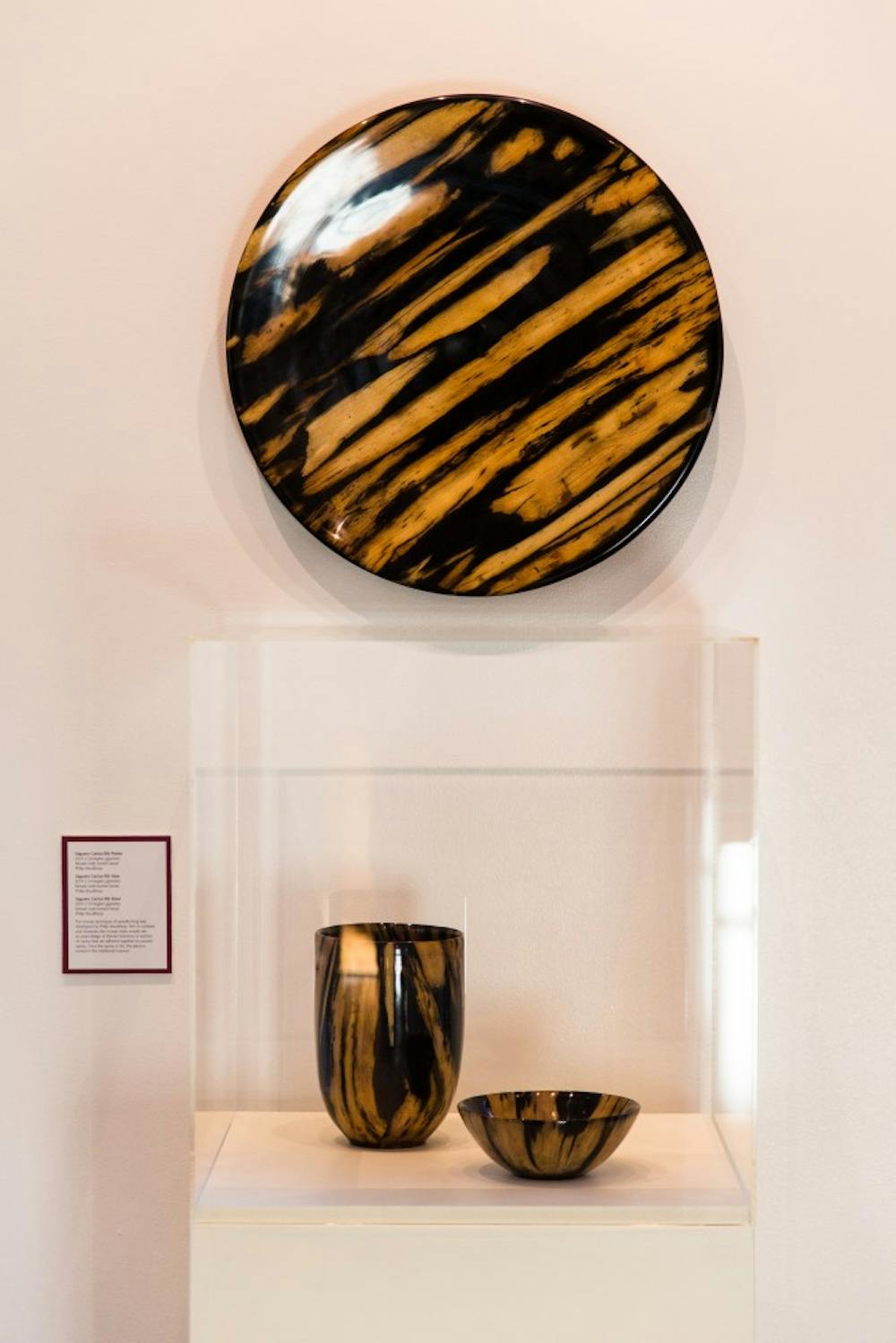 Inside of the "Arizona Indigenous: New Turned Wood" by Philip and Matt Moulthrop exhibit located in Dorrance Hall at the Phoenix Desert Botanical Gardens on Feb. 6, 2015. (Daniel Kwon/ The State Press)
Inside of the "Arizona Indigenous: New Turned Wood" by Philip and Matt Moulthrop exhibit located in Dorrance Hall at the Phoenix Desert Botanical Gardens on Feb. 6, 2015. (Daniel Kwon/ The State Press)Arizonans are known for a sun-baked stubbornness and resilience to meddling from outsiders. The new "Arizona Indigenous" exhibit of wood-turned-bowls at the Desert Botanical Gardens confirms and this debunks this stereotype.
The exhibit does this by showing the versatility of our desert's wood, from Oracle oak to Arizona blue spruce to desert ironwood. Despite this diversity, the drought and heat-resistant plants display a hardiness only tamed by a family of masterful American artists: the Moulthrops.
Three generations of the Moulthrop family, including the late Ed, his son Philip and grandson Matt, have turned wood.
"I liked it, because it let me work with my hands, which is what I enjoy, and I liked the environment of working in a workshop," Philip said.
Woodturning is an extremely involved process, beginning with a selection of wood.
As for the quality and type of wood, Philip was enthusiastic about the diversity of his selections. A Phoenix developer even sent him some wood, as did others from the Grand Canyon State.
"We just kind of relied on people to help us. That’s where all of it came from," he said.
Next, the wood is cut and mounted, using a chainsaw to cut and a lathe with a "face plate" to mount the wood.
"You take your log or piece of wood that you’re going to use and usually cut it using either a chainsaw or bandsaw and get it in proportion," he said.
Following that, the wood is mounted on a face plate using screws.
"When you turn the lathe on, it’s spinning the piece of wood," Philip said.
The top and bottom of the wood are shaved with a chisel until the shape is exactly what the Moulthrops decide is perfect.
 The Saguaro turned wood collection by Atlanta-born
The Saguaro turned wood collection by Atlanta-born woodturner Philip Moulthrop is the centerpiece of the "Arizona
Indigenous: New Turned Wood" by Philip and Matt Moulthrop
exhibit at the Phoenix Botanical Gardens. (Daniel Kwon/ The
State Press)
"And then we’ll take another tool, we’ll bore a hole down the center but not go all the way down to the bottom," Philip said. "It’s just maybe an inch above the bottom, then we take another tool and slowly cut the interior, maybe leaving a hole big enough to get your hand in, but that’s about as big as we go."
The bowl is then left to dry, sometimes for about one or two months. Once it's dry as a bone, there's some more shaving to do.
"We take off an eighth of an inch or a quarter of an inch or something and then we’ll thin it," Philip said.
The finish is applied and there's some sanding, but that's about all there is to it. The simple materiality belies the beauty found in these bowls and plates, however.
The Ottosen Gallery, a smaller space on the Garden's vast grounds, mirrors the artwork found within. It's round, light and opens slowly at the close.
Mounted on the wall, there's a mosaic-style saguaro cactus plate that is amazingly turned, Desert Botanical Garden director of exhibits Elaine McGinn said.
"He’s developed this mosaic style where he takes slices or pieces of the saguaro rib and he puts them into an epoxy," she said.
Once the bowl is turned, the results are fantastic and a little haunting, considering the saguaro ribs came from a cactus that fell over in the Botanical Gardens.
"It’s one of those things you’ve got to see," McGinn said. "I think people will see it and wonder how it was made. It’s really gorgeous."
Despite the wood being native to Arizona, the artists hail from an alien place to us here in the desert: Georgia. In fact, most of their work comes from wood turned in the southeast U.S.
"I don’t think a lot of people are as familiar with their work in the Southwest as they are in the East, and I think everyone will really love it," McGinn said.
There are 18 new pieces and six on loan. You can see the exhibit until May 3, and the Botanical Gardens are free with an ASU culture pass.
Tell the reporter your experiences with saguaro ribs at pnorthfe@asu.edu or follow him on Twitter @peternorthfelt.
Like The State Press on Facebook and follow @statepress on Twitter.




